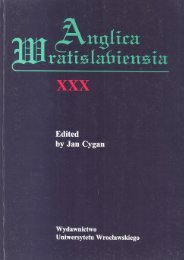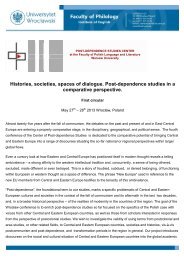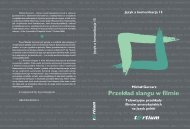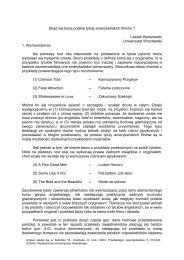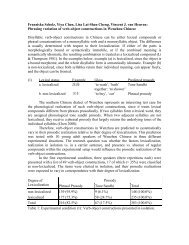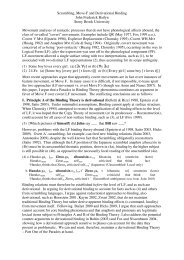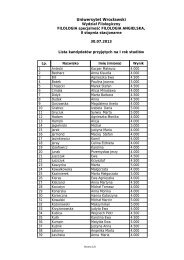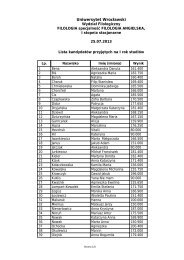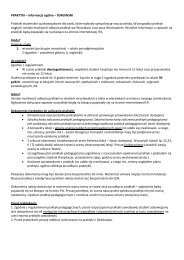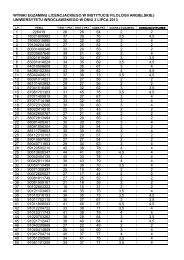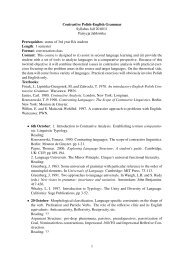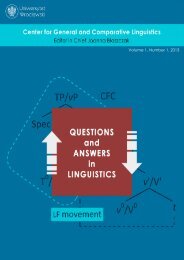Academic Journal Modern Philology
Academic Journal Modern Philology
Academic Journal Modern Philology
Create successful ePaper yourself
Turn your PDF publications into a flip-book with our unique Google optimized e-Paper software.
Language contact in New Zealand<br />
whereas Duval (1995) is reluctant to insert the term in his list of loanwords. Duval adduces<br />
the presence of the word haeana, meaning ‘iron’, in the sources that he consulted as evidence<br />
for not considering rino an English loan. According to Duval, haeana is an English loan<br />
whereas rino is not. However, despite the presence of haeana, alternative explanations for the<br />
classification of rino as a loan can be put forth The entrance of this term in the lexicon of<br />
Māori might be explained following different lines of argumentation. Rino might represent<br />
the Māori rendering of a rhotic pronunciation of the English word ‘iron’, with metathesis also<br />
involved. This is not unlikely if we consider that in the phase of intense contact, many of<br />
the settlers who migrated to New Zealand were of Scottish origin. One might also explain<br />
the classification of rino as a loan in relation to a particular contact situation characterized<br />
by the need to create a word in Māori for a specific referent that was newly introduced. In<br />
this case, the act of naming a specific entity might have involved a conscious graphological<br />
rearrangement of the English word ‘iron’ such that the same letters are maintained but their<br />
order reflects the structure of the Māori syllable.<br />
• Multiple phonological adaptation<br />
e.g. pouaka , pāki, pāka (‘box’); pēpi, pīpi (‘baby’); paoro, pōro (‘ball’)<br />
Other English words such as ‘box’, ‘baby’ and ‘ball’ give rise to multiple phonological<br />
adaptations in Māori.<br />
• Homonymous loans<br />
e.g. pea (‘pair’, ‘pear’, ‘bear’), tiriti (‘treaty’, ‘street’), pākete (‘packet’, ‘bucket’) , karaehe (‘glass’,<br />
‘class’)<br />
The fact that the sound system of Māori is smaller than that of English also gives rise to the<br />
creation of homonymous loans as the examples above indicate.<br />
• Polysemous loans<br />
e.g. waea (‘wire’, ‘cable’, ‘telephone’, ‘radio’), pāraoa (n. bread, flour)<br />
Waea is an interesting example of a polysemous loan. The term is an adaptation of English<br />
‘wire’ which was subject to semantic extension via metonymic shift. Thus, from the initial<br />
meaning of ‘wire’, waea came to indicate also ‘cable’, ‘telephone’ and ‘radio’. The loan pāraoa<br />
is another instance of semantic extension through metonymy from the meaning of ‘bread’ to<br />
that of ‘flour’.<br />
• Loans reinforced by existing native terminology<br />
e.g. huka (‘sugar’) à loan & huka (‘ice’, ‘frost’, ‘foam’) à native term<br />
e.g. kura (‘school’) à loan & kura (‘knowledge of karakia’ 3 ) à native term<br />
The introduction of the English loans huka (‘sugar’) and kura (‘school’) might have been<br />
facilitated by the existence of isomorphic native terminology having a somehow related<br />
meaning. A process of visual analogy might have guided associations between the native term<br />
huka (‘ice’, ‘frost’, ‘foam’) and the loan huka (‘sugar’). Similarly, a metonymic mapping from<br />
‘specialized knowledge’ to ‘place where to acquire knowledge’ might have helped the adoption<br />
of the loan kura (‘school’) next to the native term kura (‘knowledge of karakia’).<br />
21<br />
3 Karakia are prayers and ritual chants



